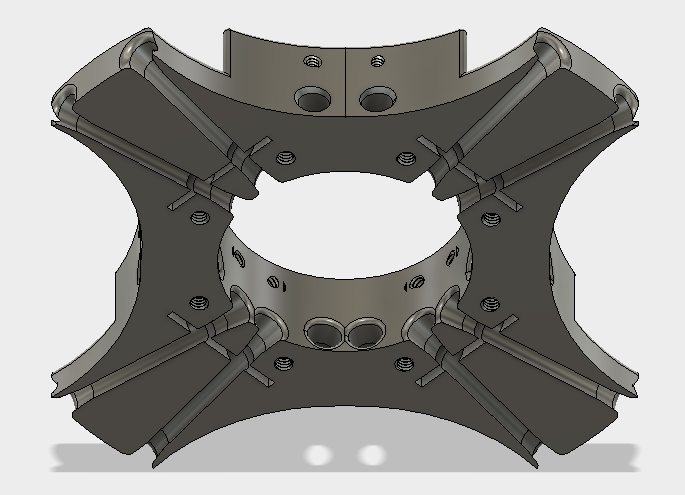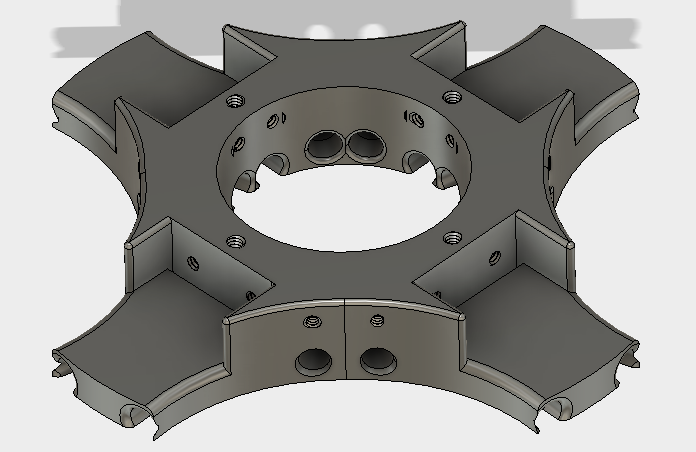beehive-varroa-barrier
A system for preventing the Varroa Mite from entering a beehive. It is printed on readily-available 3D printers using common PLA plastic.
Overview
The Varroa Mite is an external parasitic mite that attacks the honey bees Apis cerana and Apis mellifera. The disease caused by the mites is called varroosis. Once inside the brood chamber of a beehive, Varroa can reproduce and feed on the pupae.
Given the Varroa's preference to attach itself to the back of the adult bee out in the wild and to ride in between the bee's wings as seen in this photo, this design will be my attempt at taking out the mite before it gets into the hive.
Common methods for eradicating the mites once they've infested a hive is to apply a vaporized version of oxalic acid. My design attempt involves brushing each bee off so that the mite falls into a small vat of oxalic acid.
Strategy
In order for this design to work, I'll be attempting to get the bees to become more ordered. Normally, they would enter/exit the hive from the same set of holes. Here, I am attempting to segregate entrances from exits so that only the incoming bees are given the security treatment.
Top entrances & exits
Here are some screenshots of the top. These don't include the thin mylar doors but there will be one for each entrance/exit where you see a threaded hole above a bee-sized hole. The exceptions would be the flat cutouts around the inner part which are for the barrier inserts themselves.
The bottom includes four holes which should allow the Varroa to fall through a mesh and into the oxalic acid.
The underside of the middle part shows detail. The perpendicular slots in the pair of entrances are to accommodate the barrier inserts.
The top side of the middle part is shown next.
The middle and bottom together, revealing the interior detail.
Bolts
Everything is modelled with threads for imperial aluminum hex-head bolts of the 6-32 variety. The lengths range from about 1/4" to 1/2". In total, there are 36 of these used throughout.
Special attention was given to common shrinkage as seen in Z-oriented holes; horizontally-positioned bolts were modelled true.
Lid
The lid has been designed to be replaceable with other designs (like a viewing lid version) or simply removed so that a jar of sugar water may be placed on top.
Gates
This design incorporates mylar gates at one side each of the entrances/exits to enforce single-direction traffic per tube. This allows exits to be quickly navigated while still allowing entrances to incorporate the Varroa barrier itself.
Each pair of exits includes a take-off pad as separated from the standard top of the Langstroth, e.g., wooden beehive top itself. This could promote more segregation of entering/exiting bees to make movement optimal.
The expected force necessary to push through the mylar gap is anticipated to be no more than 1 gram. The thickness of the mylar selected should be as thin as possible.
Bee-havior
It is unknown at this time whether the bees will understand the mylar gate itself and how to push through it. I assume that they're smart enough to use these gates and to memorize the system. Essentially, any hole without a visible mylar gate is okay to use from the bee's perspective.
Tubes
I could have probably created more tubes for the design in the same space but I didn't want to create too much of a traffic jam in the inner circle area itself.
The inner diameter of each tube should be 5.5mm and large enough to allow any of the bees to pass through.
Barrier shims
The design includes eight vertically-adjustable barrier shims which mount to the vertical faces of the middle part. Imagine these as the soft rubber bristles of a modern toothbrush which are trapped in a shim. The shim is mounted in such a way that the bristle ends will knock off the Varroa mites which are riding on a particular bee's back. Elongated mount holes allow the shim to be adjusted.
Mesh
Not shown in the design is a mesh which lies between the middle and bottom parts coincident to the four large circles. The mesh is just large enough to allow a Varroa mite to fall through but to cause no harm to the bees themselves.
Acid tray
Not shown in the design is a tin or similar tray underneath which holds oxalic acid. Mites who fall through the mesh land in the tray and are killed/collected there for the sake of monitoring the hive's health.
| Donate | Cryptocurrency | |
|---|---|---|
 |
 |
|
| Ethereum | Bitcoin |






